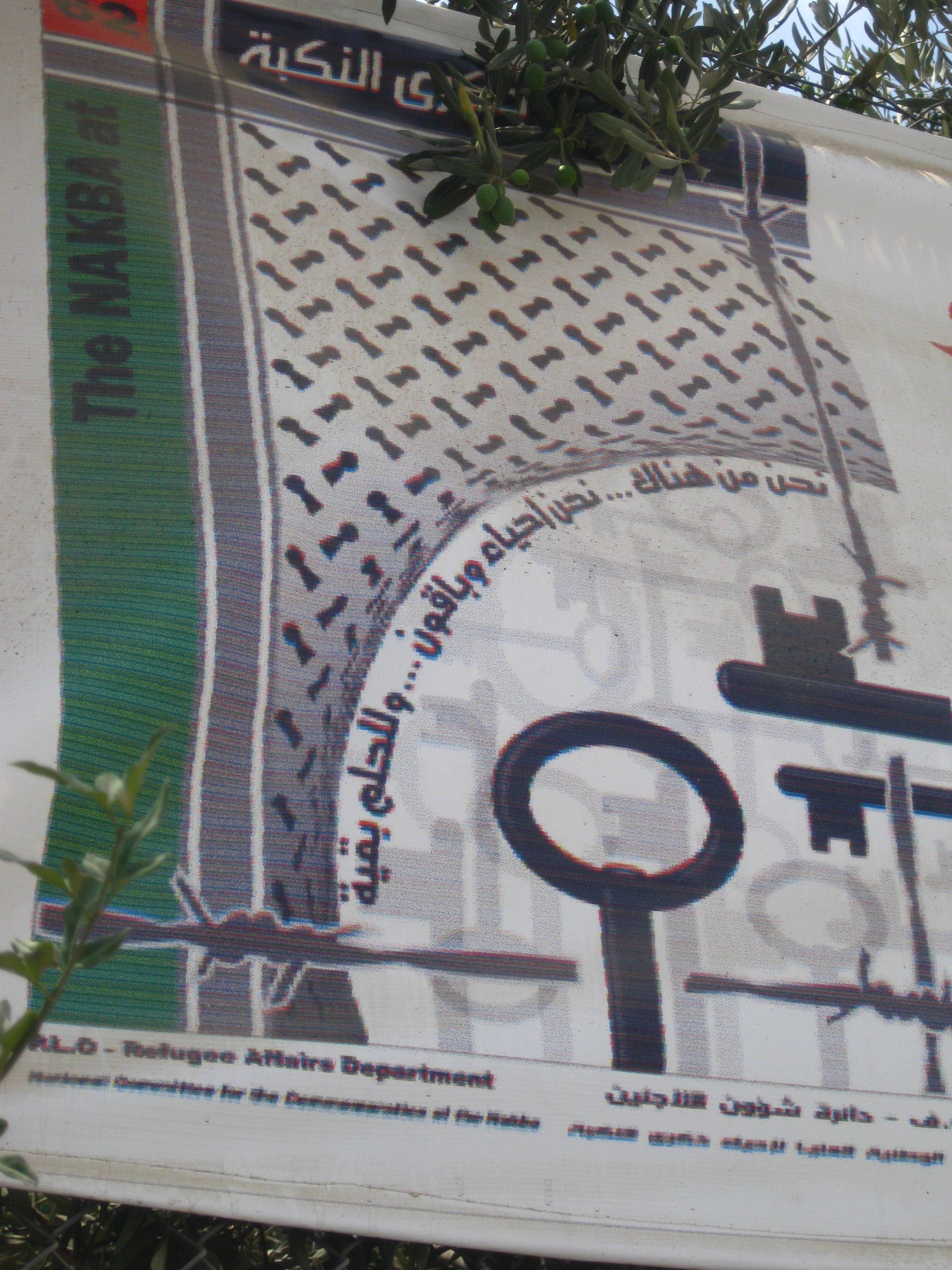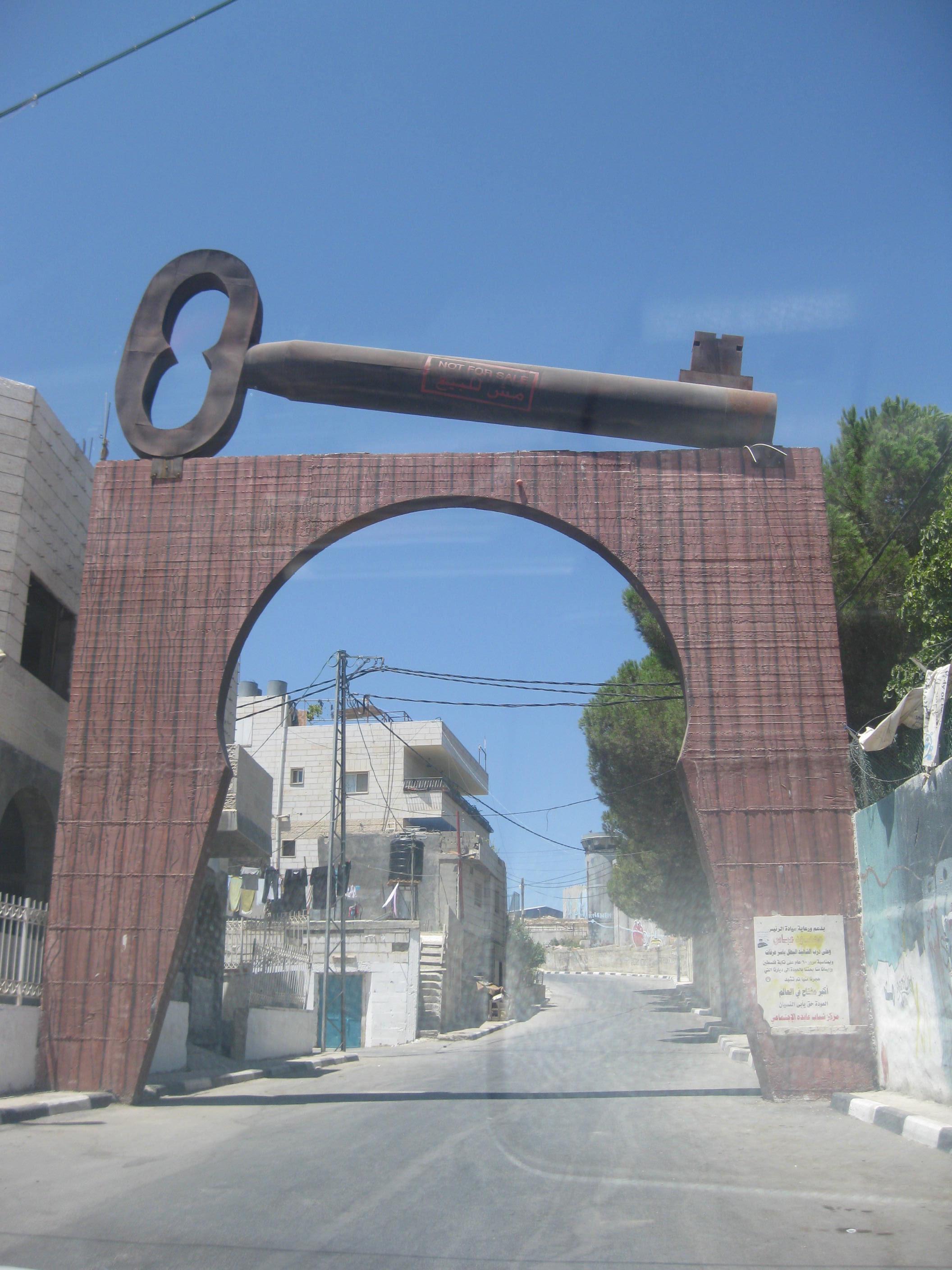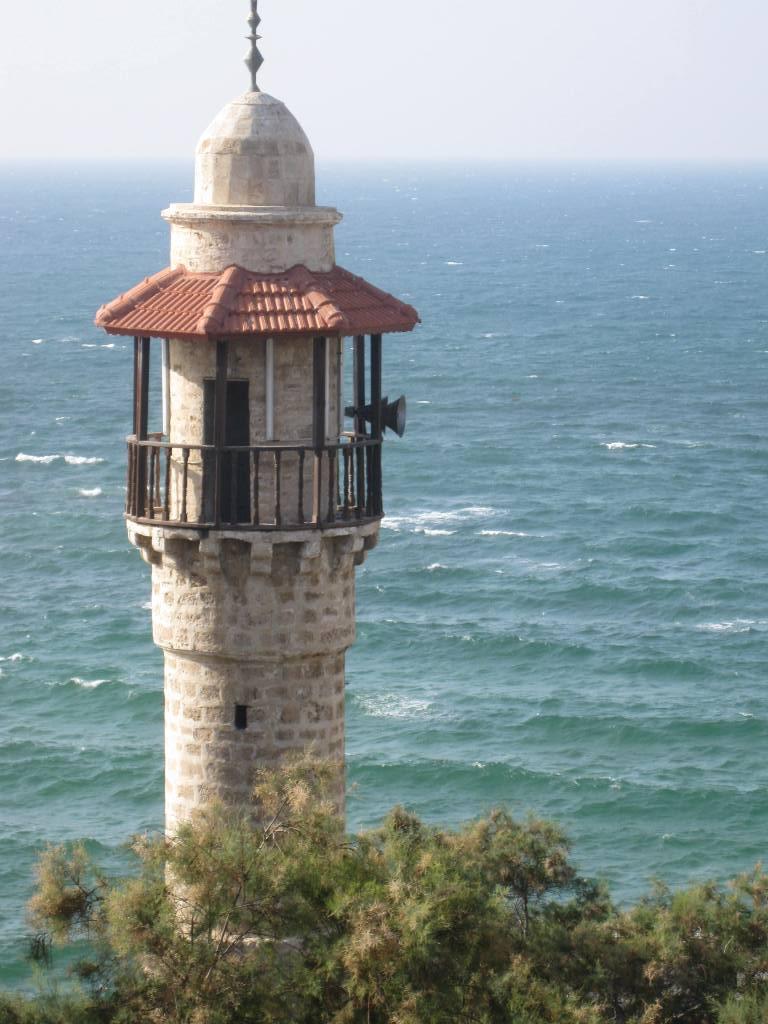|
[Editor’s note: On reading about the events of Nakba Day on May 15,2011, I thought of this past summer when I was at Kibbutz Manara which sits right on the border with Lebanon. When you walk at the back of the kibbutz you can see the UN peacekeeping forces through a fence -Kibbutzniks told me in the summer the UN forces come over and swim in Manara’s pool. From the pool one can look out and see a spectacular view of the entire area. You can see Marun Al ras three kilometers West of Manara-which is where Palestinian refugees form UNWRA refugee camps in Lebanon stormed the border with Israel on May 15 for Nakba day. On my visit, I walked to the back of the kibbutz to see the UN peace keeping force visible across the street. When I tried to photograph a member of the force, he noticed me and next thing I knew there were four of them huddling around looking at me. I only wish they had paid as much attention this week to the Palestinian refugees in Lebanon who stormed Israel’s border as they did to me when I tried to photograph them. One has to wonder what exactly they were doing to maintain Israel’s security and ensure the mob of Palestinian refugees did not breach its border on May 15? Did they see and just step aside or were they too busy swimming in Manara’s pool? ] On May 15, Omri Ceren wrote a piece in Commentary Magazine entitled “Nakba Day: UN Forces Do Little or Nothing to stop Rioting” that analyses the inactions of the UN forces on the Lebanese border and on the Golan on “Nakba Day” when Palestinian refugees from Syria and Lebanon stormed Israel’s border. Here’s what Ceren wrote: “On the Lebanese border rioters got all the way to the Israeli border at two different spots. Lebanese troops used light weapons to disperse one riot, but at Marun Al Ras the LAF [Lebanese Armed Forces] LIA was a non-presence-Lebanese soldiers literally stepped aside-and IDF soldiers had to open fire, killing as many as four. On the Syrian border thousands of people, including women and children, rushed the border fence to tear it down. The IDF commander on authorized only selective fire, and the result was that almost one hundred infiltrators managed to enter Israel… “In Lebanon we’ve been vigorously pouring weapons into the LAF since late 2007, with justifications running from “it will shame Hezbollah into disarming” to “it will allow Lebanon to secure its territory.” The subsequent half-decade has seen Hezbollah take over the Lebanese government, something that was explicitly and easily predictable when we embarked on the scheme, while the Lebanese army is still apparently torn over the need to secure their border. Lebanese soldiers have been more than willing to use US weapons to launch sniper attacks against Israelis and destabilize the region. But as far as keeping their own citizens from launching de facto invasions of neighboring countries? Not so much. “Now to the UN peacekeeping missions. Writing in one of his many retrospectives, former Israeli diplomat Abba Eban mused about the “unparalleled speed” with which UN forces stationed in the Sinai Peninsula stepped aside in May 1967, the request to evacuate having been made by Egypt so its forces could wage war against Israel. Plus ça change. “The United Nations Disengagement Observer Force on the Golan Heights is supposed to maintain “overall supervision” of the Israeli-Syrian buffer zone-that’s one of the few reasons they’re suffered to exist, and they’ve recently had their mandate extended-and it doesn’t seem like they did very much. Israeli radio says that UNDOF is even refusing to comment on the incidents. Money well spent, trust well-placed. “The performance of the United Nations Interim Force in Lebanon-which the Bush-era State Department insisted would secure southern Lebanon if Israel backed off Lebanon II-was even worse. UNIFIL has 12,000-plus troops and a budget of almost half a billion dollars. Where UNDOF is mostly just a useless money pit, however, UNIFIL actively works to destabilize the region. UNIFIL troops have broken up Israeli intelligence gathering operations, have leaked Israeli intelligence to Hezbollah, have threatened to open fire on Israeli military assets, have hidden evidence of Hezbollah attacks on Israel, have provided Hezbollah with human shields during wartime and then lied about it, have dressed terrorists in UN uniforms to smuggle them away from the IDF, and were almost certainly complicit in the Hezbollah operation that triggered Lebanon II. “UNIFIL backers justify the mission’s massive presence in the broadest terms and peacekeepers are charged with “restoring international peace and security.” In light of their functional absence during multiple, severe border intrusions today, that doesn’t seem like a tenable rationalization. “Of course maybe preventing civilian cross-border rioting isn’t what the Lebanese army and those UN missions are supposed to prevent. Maybe, for instance, they’re supposed to block Israel and Hezbollah from tangling. But since they’re utter failures when it comes to doing that, basic crowd control was really the only justification left. And now it seems absurd too, raising the question of what exactly our policies are supposed to be accomplishing.” In my view, Ceren’s article show how useless the UN peacekeeping forces are when they are needed most—It is no wonder that Israelis are reluctant to withdraw form territory in exchange for presence of UN peacekeeping forces ( remember that the US has wanted Israel to leave the Jordan valley on the premise that the UN force will be there to safeguard any incursion on Israel’s eastern front from Jordan, which would be especially likely were King Abdullah to lose power, and Palestinians who form the majority of the population of Jordan were to take over ). As analyst Lenny Ben David writes after the failure of the UN peacekeeping force,” “So much for the idea floating around Washington to meet Israel’s security demands in a peace agreement with the Palestinians by providing a foreign peacekeeping force on the West Bank.” [I recommend reading Ben-David’s examination of of media photos how Syrian, and Hezbollah involvement in sending the infiltrators to Israel’s borders what occurred on Nakba Day. lennybendavid.com Further, it should be noted that the Palestinian refugees from Lebanon weren’t running to the West Bank, which is where they would very likely be resettled if the Palestinians had a state in the West Bank. They seem to have little desire to get to the West Bank— instead they were storming into pre-67 Israel. What does this show? They want to take over Israel, not just the West Bank and Gaza (one can only surmise where exactly they would have gone, had they all gotten through the border-Haifa, Jaffa, etc ? In fact one Syrian Palestinian who go through the border made his way to Jaffa in search of his parent’s former home. http://www.haaretz.com/news/diplomacy-defense/it-was-always-my-dream-to-reach-jaffa-syrian-infiltrator-says-1.362166 ) As Prime Minister Netanyahu said in his speech to the Knesset May 16 regarding the Nakba day: “It {the Nakba] is not a conflict over 1967, but over 1948, over the very existence of the State of Israel. You must have noticed that yesterday’s events did not occur on June 5, the anniversary of the Six Day War. They occurred on May 15, the day the State of Israel was established. The Palestinians regard this day, the foundation of the State of Israel, their nakba, their catastrophe. But their catastrophe was that they did not have a leadership that was willing to reach a true historic compromise between the Palestinian people and the Jewish people.” In a separate article, on May 15, “Nakba Non Violence Will Destroy What’s Left of Peace,” Ceren outlines how the storming of the borders by Palestinian refugees has undermined the entire formula of Israel’s withdrawal from land for peace: “If international monitors are simply going to stand aside while explicitly genocidal Palestinian “refugees” rush into Israel, the Israelis will need raw space to respond. The IDF will need distance to keep infiltrators away from Israeli civilians. Israeli soldiers will need open spaces to out-maneuver rioters. “If Israel didn’t control the Golan Heights, hundreds of Syrian infiltrators would today have run down into Israel rather having run up the plateau. It’s the old concept of strategic depth, which wasn’t supposed to matter once wars became high-tech video games. It turns out that physical terrain still matters when anti-Israel fanatics, protected by their ostensibly civilian status, are trying to cross swaths of difficult physical terrain.” Evelyn Gordon in “Israel’s “Peace Partner” and the Nakba Day Riots” May 16,also in Commentary supplements Ceren’s analysis, pointing to the role of the Palestinian Authority in this: “Nakba Day protests, as Omri correctly noted yesterday, are effectively a demand for Israel’s eradication. Thus it’s important to realize that these were not spontaneous demonstrations; they were deliberately organized-first and foremost by Israel’s very own “peace partner,” the PLO headed by Mahmoud Abbas. “Last week, Haaretz reported that Ramallah was plastered with posters urging residents to take part in Sunday’s Nakba Day demonstrations. The posters bore the text of a mock letter from a Palestinian refugee to the city of Haifa, which is in pre-1967 Israel. “My beloved Haifa, I’ll be with you soon,” it read. The posters were signed by the PLO’s refugee department. “The PLO is Israel’s official peace partner. All Israeli-Palestinian agreements have been signed with the PLO, not the Palestinian Authority. Indeed, Abbas has stressed this point recently in an effort to persuade the world that his agreement to form a unity government with Hamas doesn’t preclude negotiations. It’s no problem, he asserted, because the unity government will only run the PA, while talks with Israel are conducted by the PLO (which he also heads). “But it turns out that 18 years after the Oslo Accord was signed, Israel’s “peace partner” is still telling its people that the “two-state solution” will consist not of a Palestinian state alongside a Jewish one, but of two Palestinian states: a state Judenrein in the West Bank and Gaza alongside an “Israel” that has been transformed into a Palestinian-majority state by dint of an influx of several million descendants of refugees. “Ismail Haniyeh, the Gazan Hamas leader often described by the media as “moderate” or “pragmatic,” gave a Nakba Day speech yesterday in which he declared: “Palestinians mark the occasion this year with great hope of bringing to an end [to] the Zionist project in Palestine…. Palestinians have the right to resist Israeli occupation and will one day return to property they lost in 1948.” That message is indistinguishable from the one sent by the PLO’s posters, except for one important detail. Haniyeh states the implication of his goal openly: he wants a “return to property lost in 1948” precisely because it would spell “an end to the Zionist project.” The PLO, in contrast, merely calls for a “return” to pre-1967 Israel and hopes the world won’t notice the corollary that Haniyeh crassly made explicit.” [Note: an article in Ynet shows something not in Western media-that some of the Syrians who came to the Golan, weren’t protestors, but defectors coming fro “asylum” as they are afraid for their lives under Assad. http://www.ynetnews.com/articles/0,7340,L-4068829,00.html ] |
READ COMMENTARY MAGAZINE ON NAKBA DAY: UN FORCES DO LITTLE OR NOTHING TO STOP BREACH OF ISRAEL’S BORDERS













